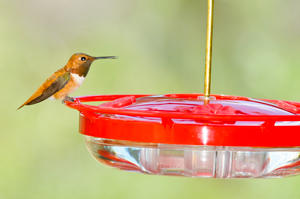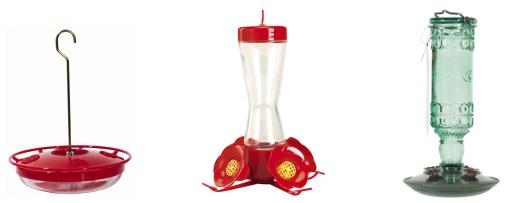How to Attract Hummingbirds

Anna's Hummingbird on Window Feeder – Local Photo by Theresa Fisher
Hummingbirds in the Bay Area
 Our most common species, Anna’s Hummingbird, is present all year round. Males are easily recognized by their iridescent red heads; females are gray and green with an iridescent throat patch. We also see Allen’s Hummingbirds during the summer, as well as other less common migrants, such as the Rufous Hummingbird to right. In summer, nectar feeders may also attract orioles, much larger golden-yellow birds who migrate here from Mexico.
Our most common species, Anna’s Hummingbird, is present all year round. Males are easily recognized by their iridescent red heads; females are gray and green with an iridescent throat patch. We also see Allen’s Hummingbirds during the summer, as well as other less common migrants, such as the Rufous Hummingbird to right. In summer, nectar feeders may also attract orioles, much larger golden-yellow birds who migrate here from Mexico.
Feeder Basics
Hummingbirds can be attracted to feeders offering sugar water, in imitation of the natural nectars found in flowers. This is a safe and beneficial food for hummingbirds, who will also continue to consume insects and visit natural flowers. Use a formula of 4 parts water to 1 part plain table sugar. Avoid sugars marketed as "natural" if they contain anything other than pure sucrose or have any golden or brownish tint; these less purified sugars contain higher amounts of iron, which can harm hummingbirds.
There are also a variety of commercial mixes sold as hummingbird food. The mixes we sell are made of finely ground sucrose, chemically identical to standard table sugar, but easier to dissolve in room temperature water. We also carry a liquid concentrate, which mixes with additional water extremely easily. We do not carry or recommend nectar solutions containing red dye, which is unnecessary and possibly harmful to hummingbirds.
Feeder Care
Normal nectar should be changed about once a week to prevent spoiling, or more often in hot weather (as often as every 1-2 days). To avoid wasting nectar, only fill your feeder to a level the hummingbirds can empty in a few days; keep a pitcher of nectar in your refrigerator for up to two weeks and refill your feeders as needed. If you have a large feeder that hummingbirds do not empty within a few days, you can also use a product called Nectar Defender, which uses micronutrient copper to slow spoiling. Nectar with this additive can stay fresh in the feeder for three weeks and is entirely safe for hummingbirds.
When you refill your feeder, rinse it out first with warm water. Every month or so perform a more in-depth cleaning, soaking the feeder in a 10% bleach or vinegar solution before rinsing thoroughly. Some feeders can also be cleaned in dishwashers. If you have some tricky nooks and crannies on your feeder, come see us – we have special brushes for different styles of hummingbird feeders.
Feeder selection
Saucer-style feeders with a simple basin and lid generally are the most functional and have fewest problems. Traditional feeders with upside down bottles may be difficult to clean and often develop leaks. Feeders that attach to windows using suction cups allow you to watch birds from very close distances. An 8–12 oz. capacity is sufficient for most people; only use a larger feeder if your birds empty it within a few days. All Wild Birds Unlimited feeders are made in the USA, have a built-in ant moat, and come with a lifetime guarantee. See our favorite models online or come in to our Novato store for our complete selection.
|
Saucer-style feeders (left) are easier to clean and never leak, but traditional or decorative models will also attract hummingbirds. |
Bees and Ants
Many people feed hummingbirds for years and never have a problem with insects finding the sugar water. But some people do. The first thing to do is make sure you are using a feeder that does not leak; saucer-style feeders are generally more reliable in this regard than upside-down bottle feeders, which often have plastic threads or rubber stoppers that wear down over time (plus – gravity!). Bottle feeders also generally have nectar reachable very close to the feeding port, while saucer style feeders keep the nectar level somewhat below the top of the port, allowing long-beaked and long-tongued hummingbirds to access the sugar water while excluding smaller insects. Some feeders may be fitted with bee guards to exclude insects from the nectar solution.
Ants and crawling insects can be excluded with an ant moat containing plain water. Many saucer-style feeders have this feature built into the feeder, but you can also purchase separate ant moats that can be hung above any feeder.
Lack of Hummingbirds
Throughout the year, feeder traffic will fluctuate with the abundance of natural food and nesting behavior: abundant flowers may mean that birds spend less time at your feeders, while the needs of nesting may keep birds close to their nesting site and mean they spend their time catching insects to feed their nestlings. While wild birds may not be as constant a presence as captive animals, learn to appreciate their freedom and their integration with a larger world beyond your feeders: they're probably just off somewhere being hummingbirds, and they will return.
When putting out a new feeder, birds often take some time to recognize it as a food source. While bright red feeders may grab hummingbirds' attention more quickly, all of the feeders we carry will attract hummingbirds given patience. Sometimes, that patience is necessary. A few days of waiting is typical if hummingbirds are already in the yard, but a few weeks is not uncommon, and occasionally it takes several months. Remember to keep nectar fresh, replacing the sugar water at least once a week (don't fill the feeder all the way up if they are not drinking it yet). If hummingbirds seem to reject a new feeder in favor of an old one, don't blame the feeder; hummingbirds are creatures of habit and they will not necessarily be in a hurry to investigate a new and unfamiliar object - especially if they have continued access to a known food source. It may help to temporarily stop filling the old feeder and placing the new (filled) feeder somewhere nearby. If the new feeder is not conspicuously red, as some more decorative models are, it may also help to temporarily attach a red ribbon to the feeder to draw the hummingbirds' initial attention.


